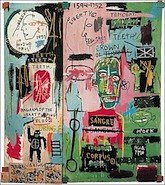Star of the Season: Paris Falls for Jean-Michel Basquiat

Thu 25 Nov 2010
In Italian, 1983. Courtesy The Brant Foundation, USA/© The Estate of Jean-Michel Basquiat/© ADAGP, Paris 2010
If you see only one exhibition while you’re in Paris, make it the Jean-Michel Basquiat retrospective. The now-astronomical value of anything touched by this artist makes it a miracle so many pieces were brought together (there are 160). But that’s not why it’s the biggest draw in town; people are going and going back again simply because they see mind-blowing art. Held in what would have been the artist’s 50th year, the show proves Basquiat’s trick of dressing home truths in magical guises still seduces after all the hype.
Jean-Michel Basquiat in his studio, New York, 1985, in front of Untitled, 1985 (detail), private collection. Photo © Lizzie Himmel/© The Estate of Jean-Michel Basquiat/© ADAGP, Paris 2010
A darling of the 1980s New York art scene, Basquiat lived hard, died at 27 of an overdose and left a rock-star legend. In that version, the young black artist is angry and sexy—and uses this to rise from painting graffiti in the streets to painting alongside Andy Warhol. Because his brief career coincided with the Wall Street Oliver Stone portrayed on-screen in Wall Street, Basquiat is often shown as a victim of his era—a talent defeated by the pressures of fame at the top. This formulaic bio has now followed him to Paris, in everything from novels (Le dernier jour de Jean-Michel Basquiat, by Anaïd Demir) to film (Jean-Michel Basquiat: The Radiant Child) to store windows, T-shirts and even commemorative sneakers. Yet the exhibition itself doesn’t romanticize anything.
Slave Auction, 1982. Centre Georges Pompidou/Don de la Société des Amis du Musée National d’Art Moderne/Photo CNAC/MNAM, Dist. RMN/Philippe Migeat/© The Estate of Jean-Michel Basquiat/© ADAGP, Paris 2010
In it, I recognize an artist I had the luck to meet. When I interviewed Jean-Michel, I was barely a student. Already a star, he was anything but a smart-ass gunslinger; we talked about bebop, Goya, music labels, art history, Cuban Chinese food and English miner’s unions. Dressed in designer clothes, he was outspoken and witty. Although I learned he was fluent in French, Spanish and English, it was clear he always let his work speak for itself. Jean-Michel had been immersed in art since the age of six (not long afterward, I learned, he lost his spleen because of a car crash). Half Haitian, half Puerto Rican and a full-on hipster, he was clearly interested in every kind of culture.
Untitled (Fallen Angel), 1981. Fondation d’Entreprise Carmignac Gestion/© The Estate of Jean-Michel Basquiat/© ADAGP, Paris 2010
At this exposition, that really shows. If you’ve never seen a great Basquiat work, there are plenty here: Versus Medici, Charles the First, Slave Auction, In Italian, Now’s the Time, Hollywood Africans, Arm and Hammer, Undiscovered Genius of the Mississippi Delta—even three of Basquiat’s classic boxing portraits. His mastery of composition and color is always startling. But it is his trademark written additions that really deepen the vision. The way words pour onto or seep out of works is all his; they’re used as ritual recitations, small poetries, markers from history.
Grillo, 1984, installation (collage, acrylic, oil, oil crayon and nails in wood). Fondation Louis Vuitton pour la Création/© The Estate of Jean-Michel Basquiat/© ADAGP, Paris 2010
Paris is also the perfect place to see this show. Parisians care about every single thing that makes up Basquiat’s art: wit; wordplay; allusions to fine art, history, cinema, comics and politics. Because Paris has known more than her share of poètes maudits, too, her critics are less keen to slap that stereotype on him. Here, whether a work taps anatomy, voodoo or advertising, whether it’s on canvas or an NFL football helmet, Basquiat is presented as what he was: a serious artist.
Critic Emmanuelle Lequeux put it best. Basquiat, she says, can be compared to many. He painted with the swing of a jazz great; he seized his moment just like Warhol; he had Keith Haring’s talent for turning speech into signs. But “there was and there remains nobody like him . . . an extraordinary painter, he created his own genre.”
An Agnès B. boutique in the 6th Arrondissement features Basquiat in its shopwindows. Photo: Cynthia Rose
Because I spoke with Jean-Michel several times about his work, it’s exhilarating to see his art treated the way it should be. The epic works are slightly minimized by a glut of lesser offerings. Nevertheless, it’s clear why the show is a smash. However crowded every room, however hard the floors, it offers amazing food for both the mind and the heart. It might change your life—or, at least, your views on art.
Jean-Michel Basquiat at the Museé d’Art Moderne de la Ville de Paris runs through January 30. Open Tuesday through Sun until 6 pm, with a nocturne every Thursday until 10; metro: Iéna. Tickets are 11 euros (free entry for visitors under 14), but you will need to book ahead, as queues run at least two hours. The huge museum has a very small café but the Palais de Tokyo next door has a busy, agreeable resto, with affordable lunch formules.
There is more Basquiat on show at La Galerie Pascal Lansberg, in the 6th Arrondissement. Photo: Cynthia Rose
Free event
Through December 4, there is more Basquiat on show, at La Galerie Pascal Lansberg (36, rue de Seine, in the 6th; 01 40 51 84 34; open Tues–Sat, 2 pm–7 pm). Works on loan for show include the large Portrait of James Brown and the drawing Matisse, Matisse, Matisse.